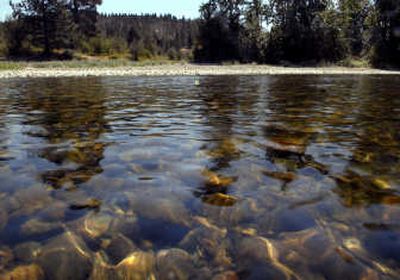More riverbank treatment for toxic metals scheduled

Two more stretches of Spokane River bank will be covered over and replanted as part of ongoing efforts to clean up heavy metals that worked their way downstream from mining in Idaho’s Silver Valley.
Last year, the federal Environmental Protection Agency covered an area near Starr Road to limit river users’ potential exposure to lead and arsenic. In the coming weeks the state Department of Ecology will undertake similar projects just upstream on the other side of the river and at a site near the intersection of River and Murray roads.
The metals tend to concentrate in sediment, as opposed to the rocky surfaces that characterize most of the riverbed. In parts of the two cleanup sites, the concentration of lead is up to twice the level considered safe, project manager Zach Hedgpeth said.
In some places, arsenic is present at levels double what occurs naturally in the region.
“That doesn’t mean every sandy area has contamination,” Hedgpeth said.
The amount of lead and other contaminants varies widely, and testing shows that high levels tend to appear only in specific spots.
In 1999 and 2000, the U.S. Army Corps of Engineers tested 30 to 40 sites along the river for heavy metals contamination. Nine were selected for possible cleanup in Washington, Hedgpeth said.
Lead and arsenic exposure are associated with elevated risks for cancer and other diseases. Lead exposure also can damage organs and is associated with nervous system problems.
Children 6 or younger have the highest risk for lead poisoning because more dirt winds up in their mouths, said Mike LaScuola, an environmental health specialist at the Spokane Regional Health District.
The agency has warned river users of heavy metals in the river for about nine years, LaScuola said. He added that if precautions are taken he doesn’t believe there is any part of the river that is unsafe to swim in because of the metals.
The treatments also isolate metals like zinc and cadmium that are harmful to birds, fish and other aquatic life.
In the coming weeks, crews will cover this year’s two cleanup sites with new soil, gravel and plants.
“We’re trying to preserve it as a natural river at the same time as providing protection,” Hedgpeth said.
The barrier isn’t permanent, but Hedgpeth said it has been designed to withstand the effects of a storm the size of which occurs every 20 to 25 years. The department will continue to monitor the sites to ensure the treatment is effective, he said.
At Murray Road, the existing footpath and vehicle pullout will be improved with new gravel, and crews will install trail signs and boulders along the path at the other site, known as the Island Complex.
A popular access for floaters and swimmers just west of the Harvard Road Bridge is being considered for a cleanup project next year, Hedgpeth said. The department also hopes to conduct similar work near Barker Road when Spokane Valley replaces the bridge there, and possibly at an access near Flora Road.
As the temperature breached 90 degrees Wednesday, several people cooled off in the river near Harvard Bridge.
Micah Kaluzny and his 2-year-old daughter Emma live nearby and visit the informal boat launch from time to time to wade, splash and play.
A nurse, Kaluzny is well aware of the heavy metals and knows the measures to take to avoid health problems. “That’s like priority one when we get home: bath time,” he said.
A kiddie pool in the backyard gets the job done for German shorthair Chica and her owner Andrea Clark, of Liberty Lake, who enjoyed the same section of rocky beach.
“It would be nice if they did clean it up,” she said, “There’s a lot of small children in this area.”